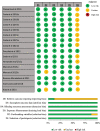Training in women soccer players: A systematic review on training load monitoring
- PMID: 35967662
- PMCID: PMC9372388
- DOI: 10.3389/fpsyg.2022.943857
Training in women soccer players: A systematic review on training load monitoring
Abstract
Objective: The present systematic review aimed to provide an overview of training load (TL), along with their responses, monitoring during training sessions in highly trained and elite adult women soccer players.
Data source: Electronic databases searches (PubMed, Scopus, Web of Science and Ebsco) for relevant studies published in peer-reviewed journals were conducted, and eligibility criteria were based on the PICOS model in accordance with PRISMA guidelines.
Study selection: Studies were considered as follows: (a) highly trained and elite adult (>18 years) women's soccer players; (b) continuous (minimum 1-week duration) TL monitoring in the context of the team routine; (c) TL collected from entire training session. Methodological qualitative assessments and risk of bias criteria were used for judging the studies.
Data extraction: A total of 1,163 studies were identified, and 16 were included. The selected studies were fully screened to extract the population characteristics; the number of players; a type of study design; region where the study was performed; the main findings.
Data synthesis: Accumulated external TL (ETL) during the pre-season was positively correlated to enhanced adaptations in intermittent exercise capacity. Daily ETL was negatively correlated to next-day self-reported fatigue and muscle soreness. Daily internal TL (ITL) was negatively correlated to post-session sleep duration and sleep efficiency. One study showed that higher accumulated player load and total distance were associated with injury.
Conclusion: Information about TL during training sessions in women soccer players is very sparse, and it is currently very difficult to consider evidence-based practices for training sessions in highly trained and elite adult women soccer players. Moreover, the dose-response relationships between TL and training outcome (e.g., fatigue, training adaptations and injuries) need to be further explored to understand the optimal training stimulus to enhance performance outcomes while preserving player health.
Keywords: female athletes; global positioning systems; heart rate; rating of perceived exertion; workload.
Copyright © 2022 Costa, Rago, Brito, Figueiredo, Sousa, Abade and Brito.
Conflict of interest statement
The authors declare that the research was conducted in the absence of any commercial or financial relationships that could be construed as a potential conflict of interest.
Figures
Similar articles
-
Relationships between rating-of-perceived-exertion- and heart-rate-derived internal training load in professional soccer players: a comparison of on-field integrated training sessions.Int J Sports Physiol Perform. 2015 Jul;10(5):587-92. doi: 10.1123/ijspp.2014-0294. Epub 2014 Dec 4. Int J Sports Physiol Perform. 2015. PMID: 25474827
-
In-season internal and external training load quantification of an elite European soccer team.PLoS One. 2019 Apr 22;14(4):e0209393. doi: 10.1371/journal.pone.0209393. eCollection 2019. PLoS One. 2019. PMID: 31009464 Free PMC article.
-
Internal and External Training Load in Under-19 versus Professional Soccer Players during the In-Season Period.Int J Environ Res Public Health. 2021 Jan 11;18(2):558. doi: 10.3390/ijerph18020558. Int J Environ Res Public Health. 2021. PMID: 33440830 Free PMC article.
-
The Relationships Between Internal and External Measures of Training Load and Intensity in Team Sports: A Meta-Analysis.Sports Med. 2018 Mar;48(3):641-658. doi: 10.1007/s40279-017-0830-z. Sports Med. 2018. PMID: 29288436 Review.
-
The Association Between Training Load and Injury Risk in Elite Youth Soccer Players: a Systematic Review and Best Evidence Synthesis.Sports Med Open. 2021 Jan 11;7(1):6. doi: 10.1186/s40798-020-00296-1. Sports Med Open. 2021. PMID: 33428001 Free PMC article.
Cited by
-
Metabolomic profiling of elite female soccer players: urinary biomarkers over a championship season.Metabolomics. 2024 Sep 5;20(5):101. doi: 10.1007/s11306-024-02164-5. Metabolomics. 2024. PMID: 39235566
-
Individual changes in neuromuscular performance in the Spanish women's national football team throughout the 2023 World Cup.Biol Sport. 2025 Jan 20;42(3):79-87. doi: 10.5114/biolsport.2025.146789. eCollection 2025 Jul. Biol Sport. 2025. PMID: 40656994 Free PMC article.
-
Female Soccer Players' In-Season Weekly Training Load and Intensity: Comparison between National League's Top and Bottom-Half Ranked Teams.J Hum Kinet. 2024 Dec 6;95:187-198. doi: 10.5114/jhk/189657. eCollection 2025 Jan. J Hum Kinet. 2024. PMID: 39944977 Free PMC article.
-
Impact of the menstrual cycle and barriers to football and futsal performance in Portuguese players: a survey-based cross-sectional study.Front Psychol. 2025 Mar 20;16:1576752. doi: 10.3389/fpsyg.2025.1576752. eCollection 2025. Front Psychol. 2025. PMID: 40181889 Free PMC article.
-
Cognitive Function among Young Women's Football Players in the Summer Heat.Transl Sports Med. 2023 Nov 2;2023:5516439. doi: 10.1155/2023/5516439. eCollection 2023. Transl Sports Med. 2023. PMID: 38654921 Free PMC article.
References
-
- Abbott W., Brickley G., Smeeton N. J. (2018). An individual approach to monitoring locomotive training load in English Premier League academy soccer players. Int. J. Sports Sci. Coach. 13 421–428.
-
- Achten J., Jeukendrup A. E. (2003). Heart rate monitoring: applications and limitations. Sports Med. 33 517–538. - PubMed
-
- Alahmad T. A., Kearney P., Cahalan R. (2020). Injury in elite women’s soccer: a systematic review. Phys. Sports Med. 48 259–265. - PubMed
Publication types
LinkOut - more resources
Full Text Sources



